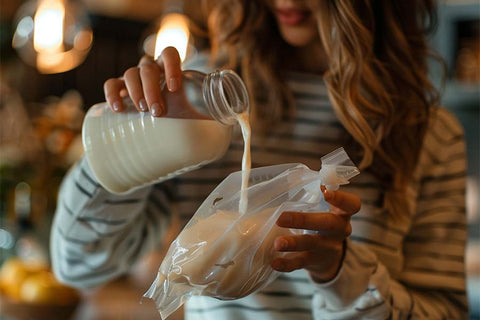As you embark on the journey of breastfeeding, understanding how to properly store and handle breast milk is crucial. Whether it's about returning to work, being away for a while, or simply ensuring that your baby can enjoy the precious breast milk whenever needed, the right storage method is key. This article aims to provide comprehensive guidance to help you safely store, thaw, and prepare breast milk, ensuring that every precious drop of nutrition is perfectly preserved for your baby. We will start with labeling storage containers, covering the techniques for freezing and thawing breast milk, all the way to the final steps of preparing it for your baby’s feeding.
Fresh breast milk storage (for healthy babies) |
|||
|
Room temperature: 16°C-25°C (66-77°F) |
Refrigerator: 4°C (39°F) or colder |
Freezer: -18°C (0°F) or colder |
Defrosting breast milk in the refrigerator |
|
A maximum of 4 hours is preferred In very clean conditions, breast milk can be stored for up to 6 hours |
A maximum of three days is preferred Breast milk can be stored for up to 5 days in very clean conditions |
Up to 6 months Breast milk can be stored for up to 9 months in very clean conditions |
At room temperature, up to 2 hours is best Refrigerator: up to 24 hours Do not freeze again |
Tips
Before expressing breast milk, mothers should wash their hands with soapy water or hand sanitizer. Breast pump parts, bottles, and the pumping area must be kept clean.
There is no need to wash the breasts and nipples before expressing.
Keep breast milk in the coldest place in the refrigerator (vegetable storage box behind glass shelf).

Frozen breast milk
Place the expressed breast milk in a bottle or storage bag. Do not fill the bottle or storage bag up to three-quarters of the way up to allow room for the volume of breast milk to expand after freezing.
Mark the storage bag or bottle with the time and date of breast milk expression, and if the milk is being provided to a daycare, include the baby’s name.
Plastic bottles or storage bags become brittle after freezing and may be damaged if dropped.
Thawed breast milk
Do not thaw or heat breast milk directly in the microwave or boiling water. Doing so helps preserve the nutrients in the breast milk and avoids the risks of nutrient loss and burns from high temperatures.
To preserve the nutrients as much as possible, it is recommended to slowly defrost breast milk in the refrigerator, preferably overnight. Alternatively, you can thaw the bottles or storage bags in warm water, not exceeding 37°C (98.6°F).
After thawing, gently shake the bottle or storage bag to mix the separated fat back into the breast milk, but be careful not to shake it vigorously to avoid damaging the nutrients.
Additionally, before feeding, it is suggested to warm the breast milk to near the baby’s body temperature to provide a more comfortable feeding experience. Please note that it is not advisable to refreeze breast milk that has already been thawed, as the repeated freezing and thawing process can degrade the nutritional content of the milk and increase food safety risks.
As we conclude this article, we hope you now possess the necessary knowledge and skills to ensure that every instance of breast milk storage is safe and effective. Remember, handling breast milk properly is not just a technical task; it's a commitment to your baby's health and nutrition. Over time, you will find this becomes a simple daily routine, allowing you to continue your breastfeeding journey with increased confidence.










